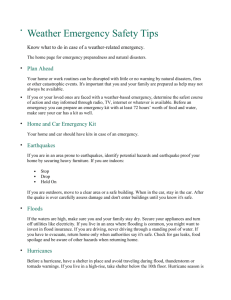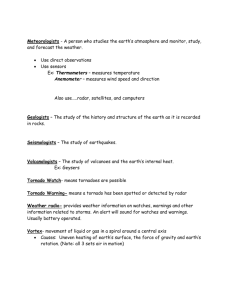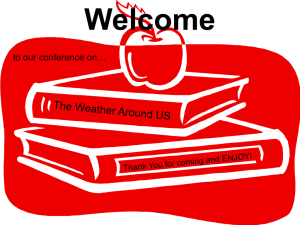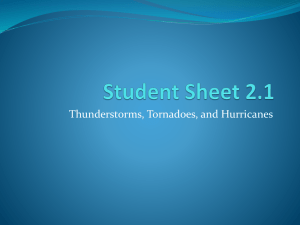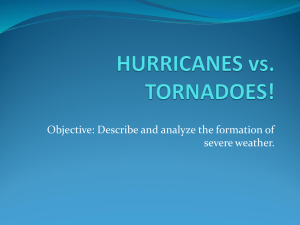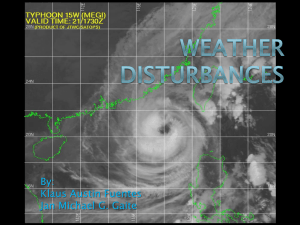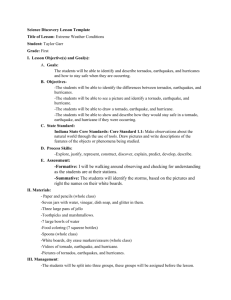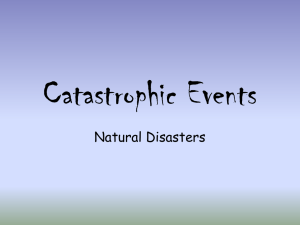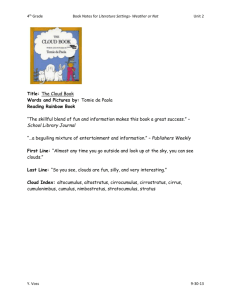What is a tornado
advertisement
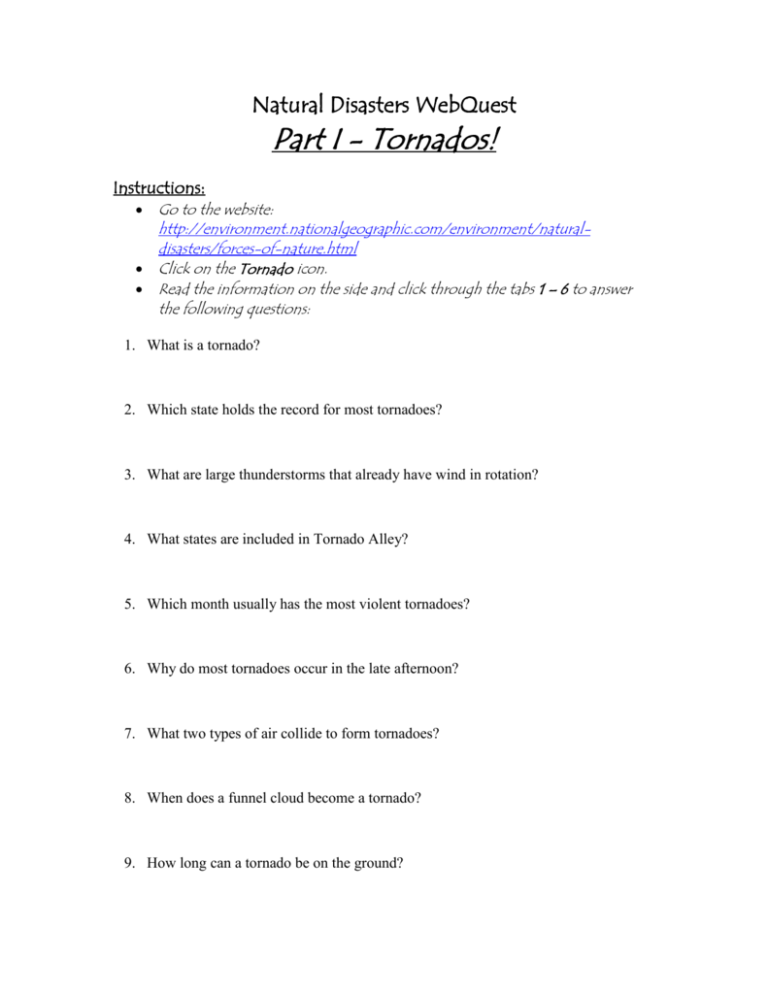
Natural Disasters WebQuest Part I - Tornados! Instructions: Go to the website: http://environment.nationalgeographic.com/environment/naturaldisasters/forces-of-nature.html Click on the Tornado icon. Read the information on the side and click through the tabs 1 – 6 to answer the following questions: 1. What is a tornado? 2. Which state holds the record for most tornadoes? 3. What are large thunderstorms that already have wind in rotation? 4. What states are included in Tornado Alley? 5. Which month usually has the most violent tornadoes? 6. Why do most tornadoes occur in the late afternoon? 7. What two types of air collide to form tornadoes? 8. When does a funnel cloud become a tornado? 9. How long can a tornado be on the ground? 10. Why can’t scientists get exact measurement of wind speed inside tornadoes? 11. What Fujita number is a tornado that levels well-constructed houses, creates large missiles, and throws cars around? 12. On average, how many people die each year from tornadoes? 13. How are most people killed or injured during a tornado? 14. What are four instruments meteorologists use to watch the skies for tornadoes? 15. What is the difference between a tornado watch and a tornado warning? 16. Name one challenge storm chasers face. 17. According to the Create a Tornado activity, what atmospheric conditions are required to create tornadoes? Click on the Case Studies tab at the upper right. Read through the case studies to answer the following questions. 18. The 1999 Oklahoma tornado outbreak produced an F5 twister. How big was it, and what kind of damage did it cause? 19. When and where did the deadliest tornado on record occur? Natural Disasters WebQuest Part II - Volcanoes! Instructions: Go to the website: http://environment.nationalgeographic.com/environment/naturaldisasters/forces-of-nature.html Click on the Volcano icon. Read the information on the side and click through the tabs 1 – 6 to answer the following questions: 1. Where do most volcanoes occur? 2. What type of volcanoes occur at spreading centers? 3. What volcanoes occur at subduction zones? 4. Which type of volcano is encircled by steep cliffs and often filled with lakes? 5. What is viscosity? 6. True or False: High viscosity volcanoes erupt more explosively than low viscosity volcanoes? 7. In the Make Your Own Volcano activity, which combination of silica content and dissolved gases erupts violently like Mt. St. Helens? Which combination erupts gently like the shield volcanoes in Hawaii? Click on the Case Studies tab at the upper right. Read through the case studies to answer the following questions. 8. When did Mt. Kalauea’s current eruption begin? 9. What volcano caused tsunamis in Indonesia over a hundred years ago? 10. Click on number “6” under the Case Studies section. Look at the pictures of Mt. Vesuvius and Pompeii. Do you think that the current residents of Naples, Italy, should be concerned for their safety? Natural Disasters WebQuest Part III - Earthquakes! Instructions: Go to the website: http://environment.nationalgeographic.com/environment/naturaldisasters/forces-of-nature.html Click on the Earthquake icon. Read the information on the side and click through the tabs 1 – 6 to answer the following questions: 1. Where did an intraplate earthquake occur in the 1800’s? 2. How deep is the San Andreas Fault? 3. Look at the animation of the different fault types. Which type is found in the Himalayan Mountain region? Which type is found in Turkey? 4. Watch the animation of earthquake waves. What are the three types of waves? What do seismologists study? 5. Click on number “6” Locate an Earthquake. Follow the instructions on screen. Where was the earthquake located? 6. Click on number 7 “Trigger an Earthquake. Select Bedrock and Low Magnitude. Describe what happens to the building. Next, select landfill and High Magnitude, and describe what happens to the building. Finally, select Fault Line and High Magnitude, and describe what happens to the building. Natural Disasters WebQuest Part IV - Hurricanes! Instructions: Go to the website: http://environment.nationalgeographic.com/environment/naturaldisasters/forces-of-nature.html Click on the Hurricane icon. Read the information on the side and click through the tabs 1 – 6 to answer the following questions: 1. What is the difference between a hurricane, a cyclone and a typhoon? 2. Where do most Atlantic Ocean hurricanes form? 3. How fast do storm winds need to be to be considered a hurricane? 4. What is the “eye” of the hurricane? What is it like inside the “eye?” 5. What direction do hurricane winds turn in the Northern Hemisphere? 6. How much rain can a hurricane cause each day? 7. What are “storm surges?” 8. Click on Change the Intensity. Observe how the strength of the hurricane changes the amount of damage. 9. Most hurricane deaths are caused by what? 10. What do “hurricane hunters” do? 11. Click on Create a Hurricane. What conditions are necessary in order for a hurricane to form? Click on the Case Studies tab at the upper right. Read through the case studies to answer the following questions. 12. Look through the pictures of Hurricane Andrew in Florida. a. What happened to the U-Haul truck? b. What happened to the sheet of plywood?


